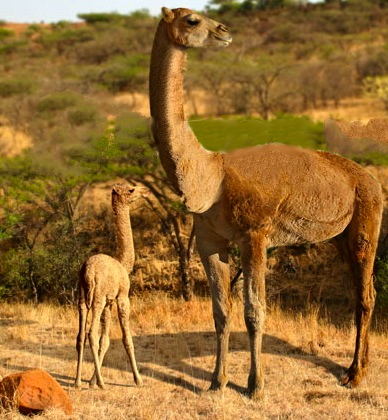Aepycamelus
The resulting 1913 drawing by Robert Bruce Horsfall gives an impression of the possible appearance of the animal.
- North America
Aepycamelus (formerly Alticamelus ) is an extinct genus of camels from North America. Fossils of these animals are known from deposits of the late Miocene.
The name of the genus means " High Grown camel ". The animals are similar in physique of a giraffe: They were unusually long-legged and wore the head on a very long neck in up to three meters in height. For comparison, a dromedary hump maximum reached at a height of about 2.3 meters. The representatives of Aepycamelus were inhabitants of open areas where they, unlike today living ( extant ) camels, fed by the foliage of bushes and trees ( foliovore nutrition).
The foot was like the of their living relatives trained as well as in the other Miocene camels. The still existing in the early camelids small hooves were already reduced and functional through the wide, elastic ball of the foot ( calluses soles ) replaced, allow the camels also on shaky ground a firm step. Even the so characteristic of recent camels ambling was probably already available. This gait is an effective way of moving in open areas where maneuverability plays only a minor role. It is documented in the fossilized tracks of Miocene camels.
Aepyicamelus ( altgr.: αἰπύς - " tall ") is the Greek equivalent to the previously used, derived from the Latin name Alticamelus ( Latin altus to - " tall " ), which was introduced in 1901 by William Diller Matthew. So both names have the same meaning. The animal was originally described in 1869 by the American vertebrate paleontologist Joseph Leidy under the name Homocamelus.
Species
- Aepycamelus alexandrae
- Aepycamelus bradyi
- Aepycamelus elrodi
- Aepycamelus giraffinus
- Aepycamelus major
- Aepycamelus priscus
- Aepycamelus procerus
- Aepycamelus robustus
- Aepycamelus stocki










